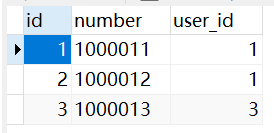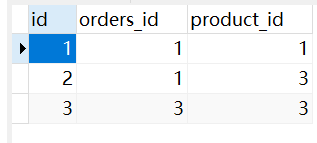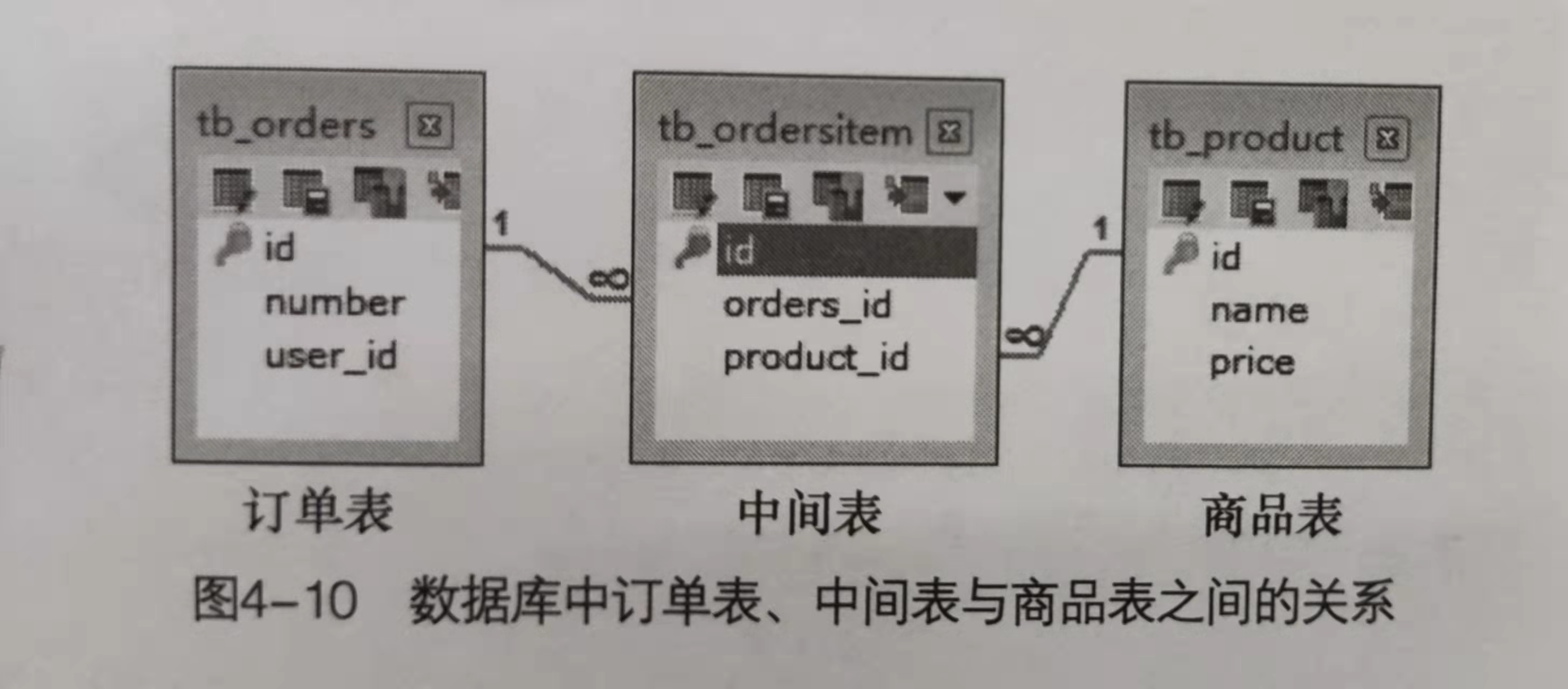表
- tb_orders
- tb_product
- tb_ordersitem



多对多查询通常需要一个中间表来维护,中间表的id作为外键关联订单表的id,中间表的商品id作为外键关联商品表的id

我们需要在实体类Product中定义与订单相关的属性,
当然在实体类Orders中定义与产品相关的属性也是可以的,只需要知道在一个实体中定义另一个实体的属性的集合即可;
如:
public class Product {
private Integer id;
private String name;
private Double price;
// private List<Orders> orders;
//此处省略getter、setter以及toSting()方法
}
//
又或者,你可以在Orders 实体中引入product相关属性的list集合:
public class Orders {
private Integer id;
private String number;
private List<Product> productList;
//此处省略getter、setter方法
@Override
public String toString() {
return "Orders{" +
"id=" + id +
", number='" + number + ''' +
", productList=" + productList +
'}';
}
}
这里使用嵌套查询的方式实现;
接口层:(可不调用接口的方式实现,这里用@Test测试方法,接口的作用时同意了namespace的命名空间)
Mapper.UserMapper.xml如下:
<?xml version="1.0" encoding="UTF-8" ?>
<!DOCTYPE mapper
PUBLIC "-//mybatis.org//DTD mapper 3.0//EN"
"http://mybatis.org/dtd/mybatis-3-mapper.dtd">
<mapper namespace="Mapper.UserMapper">
<!--多对多查询是实现 begin-->
<select id="findProductById" parameterType="Integer"
resultType="Pojo.Product">
SELECT * from tb_product where id IN(
SELECT product_id FROM tb_ordersitem WHERE orders_id=#{id}
)
</select>
<resultMap id="OrdersWithProductResult" type="Pojo.Orders">
<id property="id" column="id" />
<result property="number" column="number"/>
<collection property="productList" column="id" ofType="Pojo.Product"
select="Mapper.UserMapper.findProductById">
</collection>
</resultMap>
<select id="findOrderWithProduct" parameterType="Integer" resultMap="OrdersWithProductResult">
select * from tb_orders where id=#{id}
</select>
<!--多对多查询是实现 end-->
<!--多对多嵌套结果查询实现 begin-->
<select id="findOrdersWithProduct2" resultMap="OrdersWithProductResult2"
parameterType="Integer" >
select o.*,p.id as pid,p.name,p.price
from tb_orders o,tb_product p,tb_ordersitem oi
where oi.orders_id=o.id
and oi.product_id=p.id
and o.id=#{id}
</select>
<resultMap id="OrdersWithProductResult2" type="Pojo.Orders">
<id property="id" column="id"/>
<result property="number" column="number"/>
<collection property="productList" ofType="Pojo.Product">
<id property="id" column="pid"/>
<result property="name" column="name"/>
<result property="price" column="price"/>
</collection>
</resultMap>
<!-- 多对多嵌套结果查询实现 end -->
</mapper>
测试代码
@Test
public void findOrderWithProduct(){
// 多对多查询实现
SqlSession sqlSession = Mybatis.openSession();
List<Orders> product=sqlSession.selectList("Mapper.UserMapper.findOrderWithProduct",1);
System.out.println(product.toString());
sqlSession.close();
}
测试之前需要写一个工具类,用于建立会话工厂。
代码如下:
package Utils;
import org.apache.ibatis.io.Resources;
import org.apache.ibatis.session.SqlSession;
import org.apache.ibatis.session.SqlSessionFactory;
import org.apache.ibatis.session.SqlSessionFactoryBuilder;
import java.io.IOException;
import java.io.InputStream;
public class Mybatis {
static SqlSessionFactory factory;
static {
InputStream inputStream = null;
String resources="mybatis-config.xml";//引入mybatis配置文件
try{ inputStream = Resources.getResourceAsStream(resources);
factory = new SqlSessionFactoryBuilder().build(inputStream);
} catch (IOException e) {
e.printStackTrace(); } }
public static SqlSession openSession(){
return factory.openSession();
}}
效果

最后
以上就是搞怪犀牛最近收集整理的关于Mybatis多对多嵌套查询方式查询的全部内容,更多相关Mybatis多对多嵌套查询方式查询内容请搜索靠谱客的其他文章。
本图文内容来源于网友提供,作为学习参考使用,或来自网络收集整理,版权属于原作者所有。








发表评论 取消回复